
To prepare effectively for the TOEFL, you need to understand the TOEFL exam pattern: how the test is structured, what kinds of questions it’ll ask you, and how you can ultimately use this information to get a high score on test day.
In this guide, we go over the TOEFL pattern, for the test as a whole and for each section. Along the way, we provide you with key tips for using the TOEFL test pattern to your advantage and give you a rundown of the TOEFL structure for the paper-delivered test as well.
What Is the Overall TOEFL Exam Pattern?
The TOEFL iBT is a four-hour, computerized test with four sections: Reading, Listening, Speaking, and Writing. You’ll use one main skill for each section (so on Reading you’ll read passages and on Listening you’ll listen to audio clips), with some questions or tasks requiring the use of multiple skills.
All sections are timed. You’ll always have 20 minutes on Speaking and 50 minutes on Writing.
However, the Reading and Listening sections vary in length due to unscored, experimental questions. Reading ranges from 60 to 80 minutes long, while Listening ranges from 60 to 90 minutes long. There will be no indication telling you which questions are experimental and which ones aren’t, so don’t spend too much time worrying about this—just try your best on all questions!
Finally, you’ll have one 10-minute break in the middle of the test, between the Listening and Speaking sections. This break is mandatory, meaning you must take it. You may take other breaks during the test, but you will not be able to pause the timer for these.
The following table highlights the overall TOEFL test pattern, including the order of the sections, how long each section is, and how many questions each section contains:
By the way: we have built the world's best online TOEFL course. Get online practice (TPO-sytle!) and individual grading and feedback on Speaking and Writing.
To be fair, it's possible to get a good TOEFL score studying alone. But PrepScholar is the world's most effective TOEFL course if you are worried about the TOEFL and are struggling to improve your score.
Learn how you can improve your TOEFL score by 15 points today.
| Section | Order | Time | # of Questions | Details |
| Reading | 1 | 60-80 mins | 36-56 questions | Read 3-4 passages and answer questions |
| Listening | 2 | 60-90 mins | 34-51 questions | Listen to 4-6 lectures and 2-3 conversations and answer questions |
| Break | 3 | 10 mins | — | — |
| Speaking | 4 | 20 mins | 6 tasks | Answer prompts about familiar topics, campus situations, and academic course content |
| Writing | 5 | 50 mins | 2 tasks | Compare a passage and a lecture; write about your opinion |
| TOTAL | — | About 4 hrs | — | — |
Source: ETS.org
You may take notes on all sections of the exam. A test center administrator will give you scratch paper and pencils to use. You’ll also get a headset with a microphone to use for listening to audio clips and recording your Speaking responses.
Each section is scored out of 30 points and then combined for a total TOEFL score out of 120. For more information about TOEFL scoring, check out our guide. You’ll receive your scores in your official score report online about 10 days after your test date.
Now, let’s look at the TOEFL pattern section by section.

TOEFL Exam Pattern: Reading Section
The first section you’ll have on the TOEFL iBT is the Reading section. As mentioned above, this section can vary in length. So if you don’t get any experimental questions, Reading will be 60 minutes long and contain 36-42 questions. If you do get experimental questions, it’ll be 80 minutes long and contain 48-56 questions.
Your main task is to read passages and answer questions about them. Each reading passage is long—usually about 700 words—and you’ll have three or four passages in total (if you get four, one will be an experimental passage).
Passages deal with a variety of academic topics, from history and art to science and psychology. Each passage also comes with 12-14 questions (or a “question set”). You are not timed on each passage and question set, so it’s important to manage your time wisely. (We go over this more in tip #1 below.)
Reading is first scored in raw points (i.e., the number of points you get per question) and then converted to a scaled score out of 30. A good Reading score varies depending on where you’re applying, but generally anything above 22 (the 50th percentile) can be considered good.
TOEFL Reading Question Types
There are three Reading question types: multiple choice, Inserting a Sentence, and Reading to Learn. We explain each of these below.
Multiple Choice
Most Reading questions are standard multiple choice. These questions are each worth 1 raw point and give you four answer choices to choose from.
For this question type, you may have to define a vocabulary word in the text or answer a question about the content or form of the passage. Here’s an example of one (from the TOEFL iBT Interactive Sampler):

Inserting a Sentence
You’ll get one Inserting a Sentence question, worth 1 raw point, with each passage. This question is always the second-to-last question in a question set (right before the Reading to Learn question, which we discuss more below).
With this question, you get a new sentence and four possible places to insert it in the passage. Your task is to put the sentence in the area of the passage where it makes the most sense.
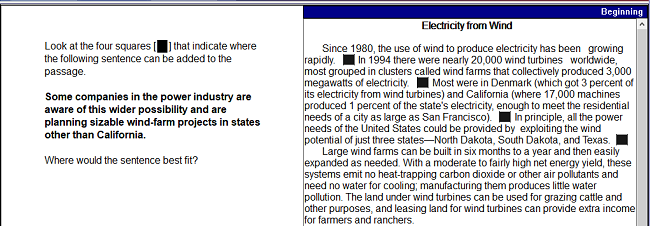
Reading to Learn
This is perhaps one of the most unique question types on the TOEFL. The Reading to Learn question requires you to arrange the main points of the passage in a chart or summary by clicking and dragging sentences.
There is only one Reading to Learn question per passage, and it’ll always come at the end of a question set.
In addition, this is the only Reading question type worth 2-3 raw points, meaning you can get partial credit if you only get some of the answers correct.
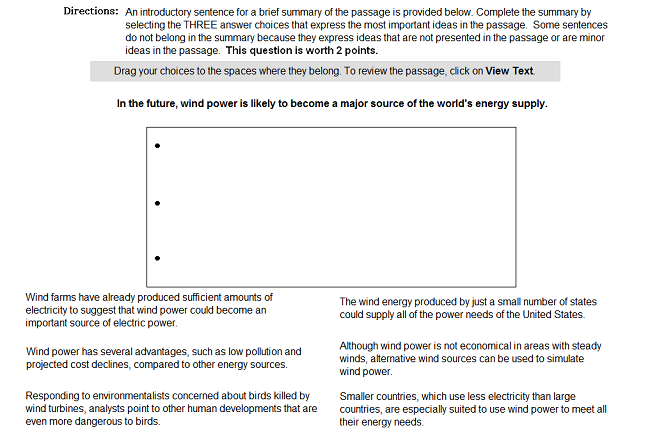

3 Tips for Attacking the TOEFL Reading Pattern
Here are our top tips for dealing with the TOEFL Reading pattern.
#1: Learn to Manage Your Time
Reading lasts 60-80 total minutes, but because there’s no timer for each passage and question set, you’ll need to practice managing your time so that you don’t accidentally run out at the end.
Here’s the best way to divide your time on Reading:
| Task | Time |
| Read a passage | About 5 mins |
| Answer a question | About 1 min each |
| Complete a question set | About 15 mins in total |
| TOTAL (passage + question set) | About 20 mins |
To recap, spend around 20 minutes total on each passage and question set. Ideally, you’ll spend five minutes reading the passage and 15 minutes answering the questions for that passage (or about one minute per question). Note that some questions, such as the Reading to Learn question, will take a little longer to complete, while others will take less time.
Try to stick to a one-minute pace per question as best you can. This prevents you from spending too much time on a single question and falling behind.
Want to improve your TOEFL score? We have the world's leading TOEFL course.
Built by world-class instructors from Harvard and MIT, the course offers individual review, interactive lessons, and realistic online praactice, at an affordable price! It's the fastest way to get your target TOEFL score.#2: Choose a Passage-Reading Strategy Ahead of Time
To do well on TOEFL Reading, you must know how to approach the passages so that you’re using your time wisely and are clearly comprehending the main points of the text.
There are a few ways you can approach Reading section passages:
- Read the entire passage first (recommended)
- Skim the passage and then answer the questions
- Answer the questions paragraph by paragraph
- Read the questions first (not recommended)
In general, the best method is to read the passage in its entirety. If you choose this strategy, spend no more than five minutes reading each passage. Be aware, though, that this method works well only if you’re highly proficient in English.
Ultimately, choose the passage-reading strategy that works best for you. To figure out which one you like the most, try out each of the four strategies above using different Reading practice tests. When finished, go with the strategy that gives you the highest score.
#3: Skip Difficult Questions and Return to Them Later
The Reading format doesn’t require you to answer a question before moving on, so use this feature to your advantage by skipping difficult questions. This way you can keep moving and answering questions on the test, even if you get stuck. You’ll also avoid spending too much time on one difficult question.
Just remember to go back and answer any unanswered questions before time runs out. Even if you have to guess, it’s better to choose a random answer than to choose nothing at all since there are no penalties for wrong answers on the TOEFL.

TOEFL Exam Pattern: Listening Section
Like Reading, Listening varies in its length and number of questions due to the possibility of getting unscored, experimental questions. This section can range from 60 minutes and 34 questions long to 90 minutes and 51 questions long.
Listening tests you on your English-listening skills. In total, you’ll listen to four to six lectures and two to three conversations. Each lecture lasts three to five minutes and comes with six questions, while each conversation lasts about three minutes and comes with five questions. You will hear each audio clip only once.
As you listen to a clip, you’ll usually get to see a picture of the speaker(s) on-screen. Here’s an example:
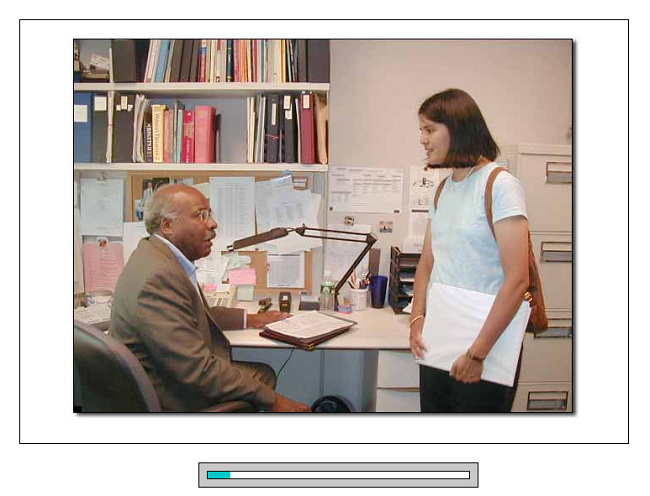
During lectures, you may also see specific terms or concepts written on a blackboard as so:

You may hear one or multiple speakers in audio clips. You’ll also hear different English accents (though most will be the North American accent).
Your Listening score is first calculated as the sum of your raw points and then converted to a final score on a scale of 0-30. A good Listening score varies depending on what schools you’re applying to, but usually anything above 21 (the 50th percentile) is a good score.
Listening Question Types
There are three question types on Listening: standard multiple choice, multiple answer, and Replay. We discuss each of these below.
Multiple Choice
This is your basic multiple-choice question and by far the most common question type you’ll see on Listening. Each question is worth 1 raw point and comes with four answer choices and one correct answer.
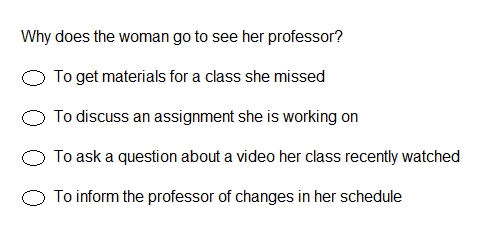
Multiple Answer
This second question type is similar to the multiple-choice question type above in that you’ll have four answers to choose from; however, you may select more than one answer choice (denoted by boxes instead of ovals).
The question will tell you how many answers to select (usually two). You get 1 raw point for each of these questions you answer correctly. There is no partial credit for this question type, so you must get all answers correct to get the point.
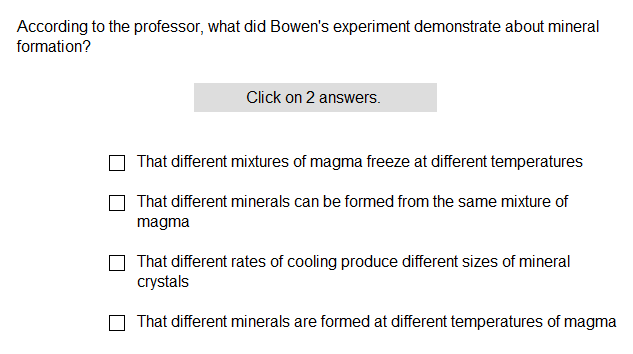
Replay
These questions replay part of the audio clip and then ask you a multiple-choice question about that part of the clip. Like the other Listening question, this one, too, is worth 1 raw point.
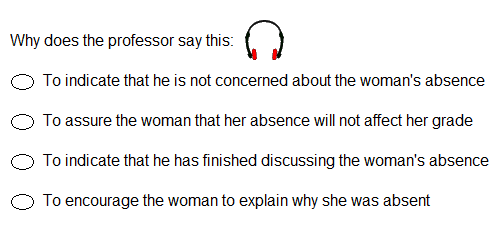

Want to improve your TOEFL score by 15 points?
Registration is now open for our best TOEFL course. We guarantee your money back if you don't improve your TOEFL score by 15 points or more.
PrepScholar TOEFL is online and it features thousands of practice questions and 1-on-1 Speaking and Writing review and feedback.
3 Tips for Attacking the TOEFL Listening Pattern
Here are our top three tips for getting the most out of the TOEFL exam pattern on Listening.
#1: Take Notes as You Listen
The Listening section has you listen to audio clips and then answer questions about them—but the hard part is that you only get to hear the clips once (except on Replay questions). And unlike the Reading section, you can’t skip around or go back to previous questions or clips.
This is why it’s so important to take notes as you listen. Doing this will help you keep track of the main topics of the audio clips and who says what, allowing you to more easily answer the questions that follow.
For more tips on how to take notes on Listening, check out our guide.
#2: Pay Close Attention to Replay Questions
Replay questions are different in that they let you re-listen to part of the audio clip. Because the answer to the question can be found in that particular part of the clip, pay close attention to the replayed part.
Even if you remember most of the audio clip or took detailed notes, really pay attention to the replayed part so that you don’t miss any key information. The answer to the question will be in this part of the clip specifically, so there’s no need to go through your notes on the whole lecture or conversation.
#3: Read Questions and Answer Choices Carefully
The Listening section pattern doesn’t let you skip around with questions like you can on the Reading section, so make sure you read all questions and answer choices carefully.
Don’t just choose the first answer choice that sounds right—take time to understand what each answer choice means, and then choose the one that most clearly and accurately answers the question. If an answer choice sounds right but doesn’t exactly answer the question, it’s probably wrong!

TOEFL Exam Pattern: Break
You’ll have one 10-minute break in the middle of the test. All test takers are required to take this break.
Here are some actions to take on your break to help you build energy for the rest of the test:
- Get up and walk around: By this point, you’ve been sitting at a computer for more than two hours! Thus, the best thing you can do for your body is to move around and take your eyes off the screen. This not only reenergizes you but also breaks up the monotony of the test.
- Use the bathroom: If you need to use the restroom (or think you might have to soon), now’s the best time to do so. Though you can go to the bathroom any time during the test, the clock won’t stop for you, so do it on your break.
- Drink some water and eat a snack: Since you can’t eat or drink in the testing room, this is a good time to not only walk around but to also replenish your thirst. Drink some water and eat a quick snack (if desired) to keep your stamina up for the second half of the test.
- Breathe and relax: Last but not least, don’t let the test get to you. Try not to worry about how you’ve done on the TOEFL so far or how you might do on upcoming sections. If you’re feeling nervous, take a few moments to breathe deeply. You can do this!

TOEFL Exam Pattern: Speaking
Now it’s time to use the microphone! The TOEFL Speaking section is the shortest section on the TOEFL, lasting just 20 minutes in total.
For this section, you’ll have six tasks. The first two tasks, the Independent tasks, require you to speak for 45 seconds about your opinion on familiar topics. The latter four tasks, the Integrated tasks, require you to speak for 60 seconds about passages and audio clips.
Speaking is scored differently than the Reading and Listening sections: each task is scored on a special scale of 0-4. These scores are then summed and converted to a final speaking score on a scale of 0-30. While the definition of a good Speaking score varies depending on what schools you’re applying to, a good score is typically considered anything above 22 (the 50th percentile).
Speaking Task Types
Every Speaking task is different, but we can divide them into two main types: Independent and Integrated.
Independent Speaking Tasks
The Independent tasks, or tasks 1 and 2, focus on familiar topics. For task 1 you must choose one of many options, and for task 2 you must choose one of two options.
For both tasks, you’ll read a prompt and then have 15 seconds to prepare your response. Once that time is up, you’ll have 45 seconds to speak. As you speak, you must support your opinions clearly and with ample examples and reasons.
Below is an overview of the two Independent Speaking tasks:
| Task 1 | Task 2 | |
| Topic | Familiar topics | |
| Directions | Choose one of several options | Choose one of two options |
| Time | Preparation: 15 seconds Speaking: 45 seconds |
|
And here’s an example of task 2:

Integrated Speaking Tasks
Integrated tasks, or tasks 3-6, require you to combine your reading and listening skills with your speaking skills. Tasks 3 and 5 focus on campus situations, while tasks 4 and 6 focus on academic course content.
For tasks 3 and 4, you must read a passage, listen to an audio clip, and answer a question about both the passage and audio clip. You’ll have 45-50 seconds to read the passage, about one minute to listen to the clip, 30 seconds to prepare your response, and 60 seconds to speak.
For tasks 5 and 6, you must listen to an audio clip and then answer a question about it. The audio clip is usually about two minutes long, and you’ll have 20 seconds to prepare your response and 60 seconds to speak. There are no reading passages for tasks 5 and 6.
Below is an overview of the four Integrated Speaking tasks:
| Task 3 | Task 4 | Task 5 | Task 6 | |
| Content | Reading + Listening | Listening | ||
| Topic | Campus situations | Academic course content | Campus situations | Academic course content |
| Time | Reading: 45-50 seconds Listening: About 60 seconds Preparation: 30 seconds Speaking: 60 seconds |
Listening: About 60-120 seconds Preparation: 20 seconds Speaking: 60 seconds |
||
Here is an example of task 4:

And here’s an example of task 5:


3 Tips for Attacking the TOEFL Speaking Pattern
Here are our top three tips for using the TOEFL pattern for Speaking to your advantage on test day.
#1: Use Your Scratch Paper to Plan What You’ll Say
Because you only get one chance to speak on each Speaking task, you’ll need to have good organization and clear ideas to get a high score. Therefore, it’s a smart idea to use your scratch paper to plan out what you’ll say.
With each task you get 15-30 seconds of preparation time, so use this to your advantage. On your scratch paper, outline two or three main points you want to discuss and, if possible, an example or two to support them.
You don’t need to get too detailed—just make bullet points of the main topics you plan to discuss. This way you can organize your thoughts better and limit the number of pauses you’ll have trying to figure out what to say next.
#2: Take Notes on Readings and Audio Clips
For tasks 3 and 4 you’ll have to read and listen, while for tasks 5 and 6 you’ll only have to listen. Since you’ll only get to read each passage and listen to each audio clip once, be sure to take detailed notes on both the passages and audio clips.
Each passage consists of about 100 words, so they’re not particularly long and are relatively easy to take notes on. However, you’ll only have 45-50 seconds to read each one, so write down important ideas as you read instead of after you finish reading.
Audio clip lengths vary but are usually anywhere from one to two minutes long. Using the note-taking tips for Listening in our guide, make a memo of the main points in each clip, who says what, and any suggestions given or decisions made.
#3: Speak Up
The TOEFL exam pattern for Speaking makes it so that other test takers in your room will likely get to the Speaking section the same time you do. This can cause the room to get louder than normal and make it difficult to ensure you’re speaking clearly into your microphone.
As a result, always speak up on Speaking tasks. Don’t yell into the microphone, but raise your voice slightly so that you’re using the same volume you’d use while giving a presentation. In the end, if evaluators can’t understand what you’re saying, you’ll lose points!
In addition, don’t forget to speak clearly and at a natural pace. You can practice these skills ahead of time by recording yourself and seeing whether there are any English sounds or words that are particularly difficult for you to pronounce.

TOEFL Exam Pattern: Writing
Finally, we get to the last section of the TOEFL: Writing. For this section, you must write two essays (an Integrated essay and an Independent essay) within 50 minutes. You’ll have 20 minutes for the first essay and 30 minutes for the second essay.
Each essay is scored using a scale of 0-5. The two essay scores are then combined and converted to a scaled Writing score out of 30. While a good Writing score varies depending on where you’re applying, in general anything above 22 (the 50th percentile) is considered a good score.
Writing Task Types
There are two types of essays you must write for this section: the Integrated task and the Independent task.
Integrated Writing Task
The first essay is the Integrated essay. For this task, you’ll have three minutes to read an academic passage of about 300 words. After, you’ll listen to an approximately two-minute-long audio clip of a lecture and then write an essay explaining how the lecture and passage support or challenge each other.
You’ll have 20 minutes to prepare and write your response. You will be able to see the passage the entire time you write. The length of your essay should be about 150-225 words.
Remember that you are not writing about your opinion for this task (though you will be doing so for the Independent task, which we look at next).
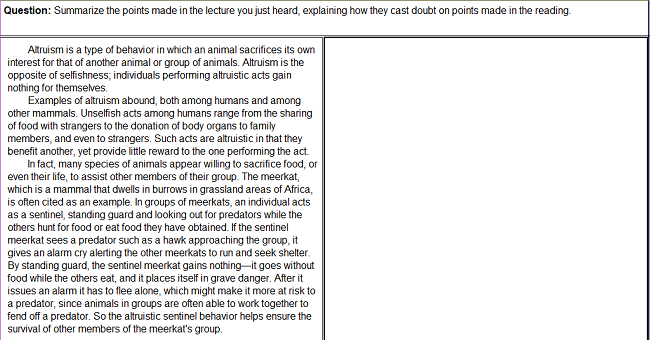
Independent Writing Task
The second essay you must write is the Independent task. Unlike the Integrated essay above, you’ll have no reading passages to read or audio clips to listen to for this task; all you’ll get is a prompt.
This prompt will focus on a familiar topic and ask for your opinion on it. You may write about your own opinion or make one up. You’ll have 30 minutes to plan and write a response of at least 300 words.
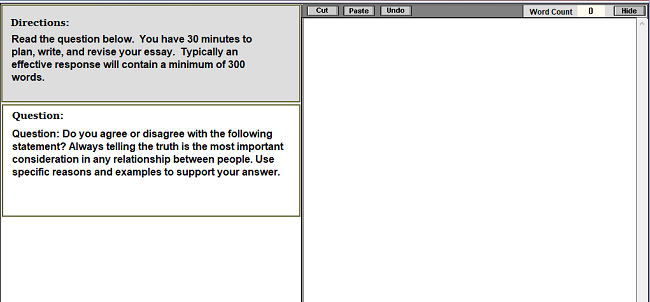

3 Tips for Attacking the TOEFL Writing Pattern
Below, we introduce our top three tips for getting the most out of the TOEFL Writing exam pattern.
#1: Outline Your Essays
You’ll have 20 minutes on the Integrated essay and 30 on the Independent one, but don’t use all of this time to write! Rather, spend the first few minutes of each task outlining your essay: create a bullet-point list of the two or three main points you want to make, and come up with examples or reasons to support them.
Don’t spend too much time outlining, though. I recommend spending up to three minutes outlining the Integrated essay and up to five minutes outlining the Independent essay.
#2: Take Notes on the Audio Clip—Not the Passage
For the Integrated task, you’ll read an academic passage and then listen to a lecture on the same topic. However, because you can read the passage again as you write your response, there’s no need to take notes on it. Instead, just focus on reading the passage and getting notes down for the audio clip.
You only get to hear the audio clip once, so make sure you’re keeping track of the main points the professor makes and how these points agree or disagree with what you read in the passage.
#3: Choose the Easier Side to Support
For the Independent task, don’t waste minutes trying to figure out how to support your opinion. If your opinion is too difficult to argue, just go with the easier side to support.
In other words, it’s OK to make up an opinion for this task—you’re not being judged on whether you’re telling the truth but on how well you can construct an argument. Thus, if the side you actually agree with is too difficult to defend, choose the easier side and focus on finding reasons to support that one instead.
What Is the Paper-Delivered TOEFL Test Pattern?
We’ve gone over everything you need to know about the TOEFL exam pattern—but what about the paper-delivered TOEFL?
This version of the TOEFL is only offered in areas where the TOEFL iBT (or “Internet-based test”) is unavailable. Most people take the TOEFL iBT, but if you’re taking the paper TOEFL, it’s important to familiarize yourself with its pattern and see how it differs from the TOEFL iBT.
Here is a brief overview of the paper-TOEFL test pattern:
| Section | Order | Time | # of Questions |
| Listening | 1 | 60 mins | 34 |
| Reading | 2 | 60 mins | 42 |
| Writing | 3 | 50 mins | 2 tasks |
| TOTAL | — | About 3 hrs | — |
Source: ETS.org
As you can see, though the two TOEFL versions share many similarities, they’re not 100 percent identical. Below are some of the key ways the paper TOEFL differs from the TOEFL iBT:
- It doesn’t have a Speaking section: Since you can’t record your responses without a computer, there is no feasible way to recreate the Speaking section on the paper test.
- It doesn’t have any experimental questions: On the TOEFL iBT, you’ll have unscored questions on either the Reading or Listening section, but you won’t get any such questions on the paper TOEFL. Thus, all Reading and Listening questions you get on the paper TOEFL will count toward your final score.
- It’s a full hour shorter than the TOEFL iBT: Without a Speaking section and experimental questions, the paper TOEFL is about an hour shorter (three hours) than the TOEFL iBT (four hours).
- Listening comes before Reading: On the TOEFL iBT, Reading comes first and Listening comes second, but these two sections switch positions on the paper TOEFL.
- It doesn’t have a 10-minute break (or any break at all): Because the paper TOEFL is shorter than the TOEFL iBT, there is no mandatory break in the middle of the test. In other words, you must take the entire paper TOEFL in one sitting.

Recap: What the TOEFL Exam Pattern Means for You
The TOEFL test pattern is generally the same for all test takers: you start with the Reading and Listening sections, have a quick 10-minute break, and then move to the Speaking and Writing sections. Depending on which section you get experimental questions, you’ll have either a longer Reading or Listening section.
Ultimately, the best way to prepare for the TOEFL pattern is to understand the format of each section and question type. You can then use this information to help you figure out how to approach different questions, take notes efficiently, and get more questions right.
We gave you 12 tips above for dealing with the TOEFL pattern for each of the four sections. So what’s our final tip? Use official TOEFL practice tests to hone your test-taking skills.
You can buy a TPO test online or use the TOEFL tests in official prep books (namely The Official Guide to the TOEFL Test and Official TOEFL iBT Tests). Taking realistic TOEFL tests will better familiarize you with the TOEFL structure, time limits, and question types.
What’s Next?
Want to know how the TOEFL is scored? Or how long the TOEFL is? Our guides explain the TOEFL scoring system in detail and go over the length of each section on both the TOEFL iBT and paper-delivered test.
How can you ensure you have a great TOEFL experience? Learn what to expect on TOEFL test day and how you can prepare effectively for it.
Need to register for the TOEFL? Follow our step-by-step guide to get started today!
Ready to improve your TOEFL score by 15 points?
Download our best TOEFL Strategy eBook (valued at $14.49) for FREE! Learn the top 5 strategies you must know to improve your TOEFL score. Download it for free now:
